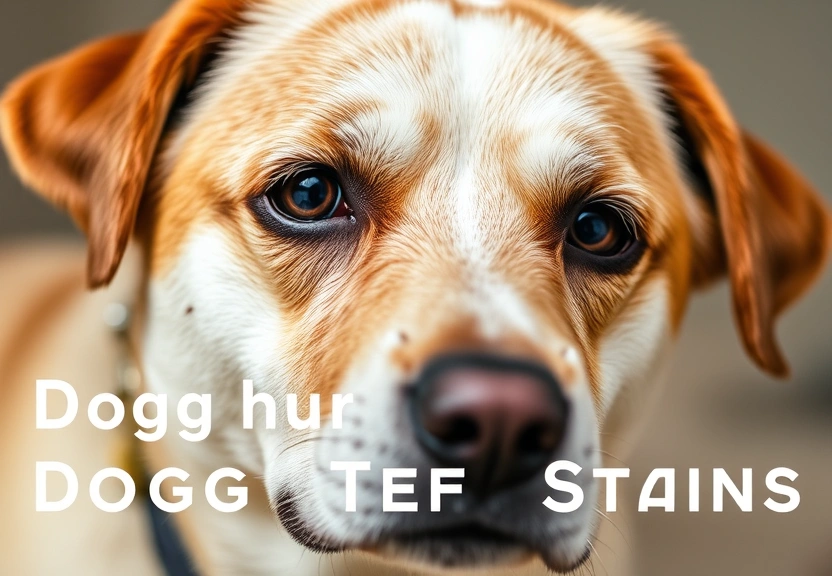Contents
ToggleNatural Solutions for Dog Tear Stains: Vet-Approved Tips and Tricks
Tear staining is a common issue among dog owners, particularly for those with white-coated breeds such as Bichon Frises, Shih Tzus, and Maltese dogs. While tear stains can occur in darker-colored dogs, they are much less noticeable, making the problem more pronounced in lighter fur. Tear stains are not just a cosmetic concern; they can also indicate underlying health issues. As responsible pet parents, it’s essential to address this issue in a manner that is safe and effective.

While commercial tear stain removers and wipes are widely available, many dog parents prefer natural remedies that are gentler on their pets. In this article, we will explore vet-approved tips and tricks for managing and preventing tear stains naturally, giving you the tools you need to keep your furry companion looking its best.
Understanding Tear Stains: Causes and Symptoms
Tear stains occur when excess tears run down a dog’s face, leading to discoloration of the fur. Understanding the underlying causes of tear stains is crucial to effectively addressing the problem. Here are some common reasons why dogs experience tear staining:
1. Genetic Factors
Some breeds are genetically predisposed to tear staining due to the shape of their eyes or the structure of their tear ducts. Breeds like Bichon Frises and Shih Tzus often have shallow eye sockets, leading to excessive tearing.
2. Allergies
Environmental factors such as dust, pollen, or certain foods can trigger allergic reactions, resulting in watery eyes and tear stains. Identifying and eliminating allergens can significantly reduce the incidence of tear staining.
3. Eye Infections and Irritations
Infections or irritations caused by foreign bodies, such as dust or hair, can lead to increased tear production. Regular vet check-ups can help detect and treat such conditions early.
4. Poor Diet
A diet lacking essential nutrients or containing fillers and additives can lead to health issues, including tear staining. Ensuring your dog has a balanced diet can help improve their overall health and reduce tear stains.
🎥 Assista esta análise especializada sobre Natural Solutions for Dog Tear Stains: Vet-Approved Tips and Tricks
Natural Remedies for Dog Tear Stains
Now that we understand the causes of tear stains, let’s explore some natural remedies that can help alleviate the issue. These solutions are effective, safe, and vet-approved.
1. Regular Cleaning
Keeping the area around your dog’s eyes clean is crucial. Use a soft, damp cloth to wipe away any tear stains daily. This will not only help remove existing stains but also prevent new ones from forming.
2. Apple Cider Vinegar
Apple cider vinegar is known for its antibacterial properties. Adding a small amount (1 teaspoon) of organic, unfiltered apple cider vinegar to your dog’s water can help balance their pH levels and reduce tear staining.
3. Coconut Oil
Coconut oil is another natural remedy that can help with tear stains. Its moisturizing properties can soothe the skin around your dog’s eyes. Apply a small amount of virgin coconut oil to the stained area and gently massage it in.
4. Herbal Teas
Some herbal teas, such as chamomile or fennel, can be beneficial for tear stains. Brew a tea, let it cool, and use a clean cloth to wipe your dog’s face. The anti-inflammatory properties of these herbs can help reduce tearing.
Veterinarian-Approved Tips for Prevention
In addition to natural remedies, there are several vet-approved tips that can help prevent tear stains from forming in the first place. These proactive measures can be a game-changer for dog owners.
1. Maintain Good Eye Hygiene
Regularly check your dog’s eyes for any discharge or debris. Keeping the eye area clean can prevent tear staining from worsening.
2. Monitor Diet
Feeding your dog a high-quality diet rich in vitamins and minerals will support their overall health. Look for dog food that contains real meat and avoids fillers like corn and soy.
3. Stay Hydrated
Ensure your dog has access to fresh, clean water at all times. Proper hydration can help minimize excessive tearing.
4. Consult with Your Veterinarian
If tear stains persist despite your efforts, consult with your veterinarian. They can rule out any underlying medical conditions and may recommend specialized treatments or dietary adjustments.
Important Points to Remember
- Tear staining is common in white-coated breeds but can affect any dog.
- Regular cleaning and maintaining good eye hygiene are essential.
- Natural remedies like apple cider vinegar and coconut oil can be effective.
- Diet plays a significant role in managing tear stains.
- Consult your veterinarian for persistent tear staining issues.
Frequently Asked Questions (FAQ)
1. What are tear stains in dogs?
Tear stains are the discoloration around a dog’s eyes caused by excessive tearing. This is particularly noticeable in light-colored breeds.
2. Are tear stains harmful to my dog?
While tear stains are primarily a cosmetic issue, they can indicate underlying health problems, such as allergies or infections. It’s important to monitor your dog’s eye health.
3. Can tear stains be prevented?
Yes, regular cleaning, maintaining eye hygiene, proper diet, and monitoring for allergies can help prevent tear stains from forming.
4. How often should I clean my dog’s eyes?
It is recommended to clean your dog’s eyes daily, especially if they are prone to excessive tearing.
5. Is it safe to use commercial tear stain removers?
While many commercial tear stain removers are safe, they may contain chemicals that could irritate sensitive skin. Always consult your veterinarian before using any new products.
Conclusion
Tear stains can be a frustrating issue for dog owners, especially for those with white-coated breeds. However, by understanding the causes of tear staining and implementing natural remedies and preventative measures, you can keep your furry friend looking clean and healthy. Always consider consulting with your veterinarian if you have concerns about your dog’s tear stains. With the right approach, you can effectively manage this common problem and ensure your dog remains a happy and healthy member of your family.
📰 Original Source
Este artigo foi baseado em informações de: https://www.dogster.com/dog-health-care/how-to-remove-dog-tear-stains-naturally-updated





